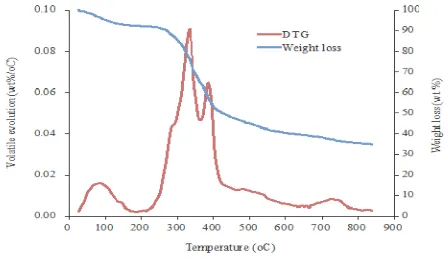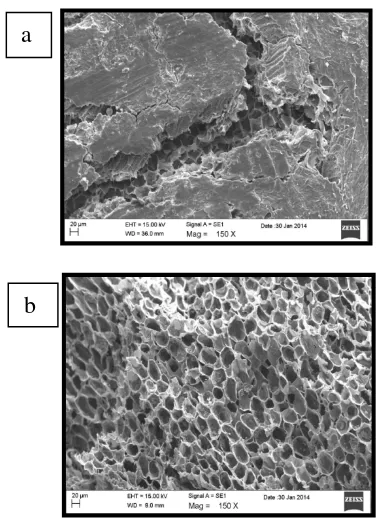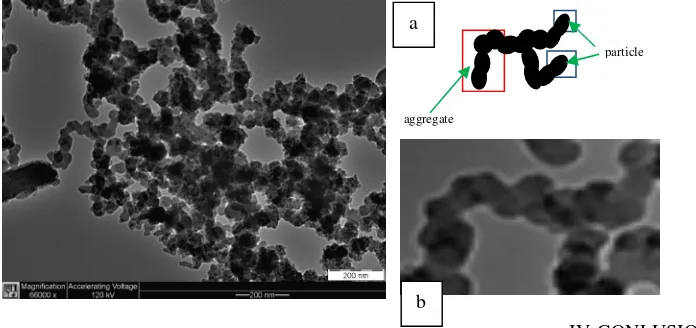International Journal of Science
and Engineering(IJSE)
Home page: http://ejournal.undip.ac.id/index.php/ijse
Properties of Carbon Black from
Jatropha
Seed Shell as A
Potential Source of Filler Enhancement in Biocomposites
N. A. Sri Aprilia
1#, H.P.S. Abdul Khalil
2, Amri Amin
31 #Chemical Engineering Department, Engineering Faculty of Syiah Kuala University, Banda Aceh, Indonesia; 2 School of Industrial Technology, Universiti Sains Malaysia, 11800 Penang, Malaysia
3 Engineering Department, University of Abulyatama, Lampoh Kedee, Aceh Besar, Indonesia
Email: [email protected]
Abstract - The use of biomass as filler in biocomposites are becoming widespread in the present decade because its variety of advantages. Jatropha (jatropha curcas L) seed shell after separated from kernel can be used to produce carbon black because of its higher carbon content, and have the potentiality to use as reinforcement in composites. In this study, carbon black was produced from jatropha seed shell by carbonization in furnace method for 1 hour at 600oC. Thermo gravimetric analysis to analyze seed shell of jatropha as raw
material. The morphological properties of the carbon black were analyzed by elemental analysis by X-ray (EDX), SEM, TEM, XRD, SEM, and TEM. It was found that the yield of carbon black was 40% which included 4 different sizes ranging from 70 – 300 mesh in distribution of particle size analysis. Carbon black suggested that it could be a good filler or reinforcement in biocomposites.
Keywords—Jatropha seed shell, carbonized particles, morphology, properties and particle size distribution
Submission: September 10, 2015 Corrected : October 18, 2015 Accepted: April 1, 2016
Doi: 10.12777/ijse.10.2.58-62
[How to cite this article: Sri Aprilia. (201). Properties of Carbon Black from Jatropha Seed Shell as A Potential Source of Filler Enhancement in Biocomposites, International Journal of Science and Engineering, 10(2),58-62. Doi: 10.12777/ijse.10.2.58-62]
I. INTRODUCTION
Biomass are materials renewable and abundant in the world. Reinforcement of biomass in composite will increase mechanical properties for many application.Carbon black is very important material widely used as filler in composites. Structure and configurations of particles influence properties of carbon black (Stabik et al., 2012). The principal uses of carbon black are as a reinforcing agent in rubber compounds (especially tires) and as a black pigment in printing inks, surface coatings, paper, and plastics, Antal et al., 2003. Carbon black is a product of incomplete combustion. It is the dark component of smoke and in fact all carbon black processes start with the production of a smoke.
To achieve the green composites, many researcher concern to agriculture biomass resource. Agricultural by products and waste materials used for the production of carbonized particle have studied by several researcher include olive mill waste and sewage sludge (Gokce et al., 2009), coconut shells (Young et al., 2010, Li at al., 2009). jatropha hull (Xin-hui
et al., 2011), jatropha fruit shell (Tongpoothorn et al., 2011,
Ramakrishnan et al., 2009, Karthikeyan et al., 2008,
Sricharoenchaikul et al., 2007), jatropha curcas pods (Sathishkumar etal., 2012), Delonix Regia Seed
Shell,Ferronia Seed Shell, Ipomea Carnia Stem (Karthikeyan
et al., 2008), olive bagasse(Demiral etal., 2011), rice husk
(Wang et al., 2011) this carbon black have activated and successfully used for the adsorption processes and another application.
Several researcher have studied of carbon black from biomass as a filler in biocomposites. Bioresource that used in biocomposite are bamboo (Khalil et al., 2007), coconut shell, oil palm empty fruit bunches (Khalil et al., 2010, 2012), carbon residue derived from woody biomass (Pries et al., 2010), carbonized bagasse filler in rubber product (Osarenmwinda and Abode, 2010) have been investigated.
husks by (Singh et al., 2008 and Vyas and Singh, 2007) showed that the husks contained 4% ash, 71% volatile matter and 25% fixed carbon. The chemical analysis of jatropha shell are 34%, 10% and 12% cellulose, hemicellulose and lignin, respectively (Singh et al., 2008). Volatile matter, ash and fixed carbon content of the shell have been shown to be 69%, 15% and 16% (Singh et al., 2008 and Jingural at al., 2010). On the other hand, the by product such as seed shell contain fixed carbon can be an alternative to make carbon black as bio filler in biocomposites (Khalil at al., 2013).
Two main reasons to employ particle size characterization, e.i., better control of product quality and better understanding of products, ingredients and processes. Filler from biomass is a diluent and is used primarily to lower volume cost. With use, all fillers modify certain physical properties of the compound in addition to lowering cost. Therefore, lower cost is generally achieved at the expense of other desirable properties and all compounds are compromises with various trade-offs considered and balanced by the compounder (Sri Aprilia et al., 2014).
The objective of this study was investigated to get an excellent carbon black from jatropha seed shell as raw material filler for reinforcement in biocomposite and characterization physico-chemical properties of carbon black to determine elemental analysis by X-ray (EDX), SEM, TEM, XRD.
II. MATERIAL AND METHOD
Procedure
Jatropha curcas L seed shell originated from Aceh
Province, Indonesia. The kernel were manually removed from the seed. The seed shell were washed with distillate water to remove the foreign materials and oven dried for 24 hours at 105 °C. The dry materials were sieved to the particle size of 2 to 5 mm and stored in airtight container for further experiment. The average proximate analysis of jatropha seed shell represented in weight percent, shows a moisture content of 5.68%, a volatile matter of 64.63%, fixed carbon of 25.34% and ash content of 3.82%.
Thermogravimetric analysis
Thermal degradation of jatropha seed shell was determined using a pyris Diamond TG/DTG thermal analyzer (Perkin-Elmer). The sample amount 3 mg (± 0.5) of jatropha seed shell was heated from 30 to 800oC at a rate of 20 oC/min
carbonization the sample was cooled to room temperature. The carbonized product were ground in different grinder. A big grinder (Mukmin Enviro) and than continue with small grinder (Retsch). Sieving process to get particle size of carbon
analysis elemental of carbon black. This machine also conducted with this FE SEM. Microscopic images of carbon black were obtained by scanning electron microscope (SEM
model EVO MA10, Carl- ZEISS SMT,
Germany).Transmission electron microscopy (TEM) images of carbon black of jatropha seed shell were taken by placing a drop onto a carbon film supported by a copper grid. A Philips CM12 instrument. The carbon black obtaining after UV cured were cut by means of a microtome (LKB model 8800) and placed on the observation grid to get them TEM images.The diffractograms for carbon black specimens were measured by a Philips pw 1050 x-pert diffractometer recorded using Cu k radiation (k = 1.54 A). X-ray unit operated at 40 kV and 25 mÅ. An X-ray diffractometer (XRD) was used to investigate the surface inorganic components of the prepared carbon black. The X-ray pattern was recorded in an angel of 20o to 80o of 2θ.Distribution of particle size analysis on
carbon black was used by the long Benc Mastersizer S (Malven Instruments) fitted with the Qspec Dry Powder Feeder. Sample weight in 2 gram were prepared for this analysis. The number distributions at 10%, 50% and 90% cut-off point as well as the number mean diameter.
III.RESULTANDDISCUSSION
Thermal Degradation of Jatropha Seed Shell
Thermogravimetry analysis is study a formation on thermal behavior of the starting jatropha seed shell to form carbon black. Figure 1 show thermogravimetry (TG) and differential thermogravimetric (DTG) curves of mass loss of
jatropha seed shell in the range 30–800 oC.
Figure 1. Thermogravimetric analysis of jatropha seed shell showing weight loss and DTG plot.
From this analysis show the initial weight loss coresponds to moisture removal at 100o, degradation of biomass at
200-375 oC, and degradation of lignin at >375 oC. Tongpootthorn
et al., 2011 and Sricharoenchaikul et al., 2008 has mentioned
Elemental composition of carbon black
Table 1 shows the major compound in carbon black from
jatropha seed shell at 600oC in furnace methods at 1 hour by
Energy Dispersive Analysis of X-Ray (EDX).
Table 1. Elemental composition carbon black
jatropha seed shell
Element Weight% Atomic%
C 74.25 81.97
O 20.85 17.28
K 1.57 0.53
Au 3.33 0.22
Carbon is a main compound in carbon black of jatropha seed shell carbonization, this is about 74.25 weight % and 81.97 atomic %. Carbon is main product degradation of hemicellulose, cellulose and lignin from biomass. Oxygen is the important compound, and in determines the properties of carbon black. Oxygen present during the carbonization process to produce carbon black.
Morphology of carbon black
Surface structure of jatropha seed shell and carbon black
jatropha seed shell has investigated by SEM in Figure 3. The
surface is not smooth and rough on the surface shell. After carbonization of lignocellulose and attractive compound in biomass at 600oC at one hour in furnace method, the black
color, sponge shape was occurred.
Figure 4 shows the surface structure of carbonized
jatropha seed shell after sizing in four sizes. This figure
revealed change in surface morphology of char as a function of size after carbonization. The surface area shows relatively smooth as well as cracked and pitted morphology. The four sizes of carbonized particles are not different in structure.
TEM has long been employed in the study of carbon black micro-structure. TEM images of carbon black from jatropha
seed shell is given in Figure 5. Regardless of varying average particle size from carbon black, some common features can be extracted from the observations. Zhu et al, 2004 has stated in their writing that particles in the carbon blacks are commonly fused together to form aggregates so that clear boundaries among particles are difficult to define (Figure 4a and 4b). Aggregate is commonly the primary structural unit for carbon black. One notable tendency is that the same aggregate appears to comprise particles of comparable size. The particle shapes are always nearly spherical. Pores are present within and among the aggregates.
Figure 3. Surface structure of: a. Jatropha seed shell and b. carbonized jatropha seed shell
Figure 4. SEM of carbonized jatropha seed shell in size: a. 70-100 mesh,
b. 100-150 mesh, c. 150-300 mesh, and d. > 300 mesh.
d
a
b
c
a b
c d
a
particle
aggregate
Figure 5. TEM of carbon black from jatropha seed shell; a. Image of a particle and aggregate,
b. TEM part of carbon black
XRD of carbon black jatropha seed shell
Figure 7 show X-ray diffraction patterns that were recorded in order to determine the degree of crystallinity of the carbon black. The appearance of broad peak centered at
the 2θ angle of 23o in the X-ray diffractograms of
carbonization. Sricharoenchaikul et al, 2008 has indicated the
presence of silica in this peak. At 2θ angle of 43o, the
graphitic basal panel could be seen in the spectrum of carbonizaion of carbon black. This is also imply by Chiravoot Pechyen et al, 2007 and Wimonrat et al, 2011, which confirm the structure of graphitic basal plans of char crystallite in the low angle region and radial spread of crystalline structures in high angle region in the similar broad peak. Hence, the product carbonization from jatropha seed shell obtain are belived to be in the form prymary particles of small graphitic sheets.
Figure 7. X-ray diffraction analysis of carbon black from
jatropha seed shell
IV.CONLUSIONS
It can be concluded that by-product of palm oil plantation and mill had good nutritional value. Therefore, this feedstuff can be used to formulate complete feed for sheep. It also proved that this effort successfully increased the nutrient digestibility.
ACKNOWLEDGMENT
The author would like to thank to staffs Laboratory of Bioresources, Paper and Coating, School of Industrial Technology, Universiti Sains Malaysia, for the facilities and supports during the research.
REFERENCES
Abdul Khalil H.P.S, N.Z. Noriman, M.N. Ahmad, M.M. Ratnam and N.A. Nik Fuaad. 2007. Polyester composite filled carbon black and activated carbon from bambo (Gigantochloa scortechinii): Phisical and mechanical properties, Journal of Reinforced Plastick and Composite, 26: 30.
Abdul Khalil H.P.S, P. Firoozian, I.O. Bakare, Hazizan Md. Akil, Ahmad Md. Noor. 2010. Exploring biomass based carbon black as filler in epoxy composites: Flexural and thermal properties, Materials and Design, 31: 3419–3425
Abdul Khalil H. P. S, P. Firoozian, M. Jawaid, H. M. Akil, A. Hassan. 2012. Preparation of activated carbon filled epoxy nanocomposites, Morphological and thermal properties, Journal of Thermal Analysis and Calorimetry, 110:1.
Abdul Khalil H.P.S, N.A. Sri Aprilia, A.H. Bhat, M. Jawaid, M.T. Paridah, and D. Rudi, A. 2013. Jatropha biomass as renewable materials for biocomposites and its applications, Renewable and Sustainable Energy Reviews, 22: 667-685.
Antal M.J, Jr., Kazuhiro M, and Lloyd S. Paredes. 2003. Flash Carbonization of Biomass, Ind. Eng. Chem. Res., 42:3690-3699.
Demiral H, I. Demiral, B. K. lu, F. Tümsek. 2011.Production of activated carbon from olive bagasse by physical activation, chemical engineering research and design, 89:206–213.
Gokce C. E, S. Guneysu, S. Aydin and S. Arayici. 2009.Comparison of Activated Carbon and Pyrolyzed Biomass for Removal of Humic Acid From Aqueous Solution,The Open Environmental Pollution & Toxicology Journal, 1:43-48
Jingura R.M, D. Musademba, R. Matengaifa. 2010. An evaluation of utility of Jatropha curcas L. as a source of multiple energy Carriers
International Journal of Engineering, Science and Technology, 2 (10): 115-122.
Karthike Yan S.K, P. Sivakumar and P.N. Palanisamy. 2008.Novel a
62 Li W, J. Peng, L. Zhang, K. Yang, H. Xia, S. Zhang, Sheng-hui Guo. 2009.
Preparation of activated carbon from coconut shell chars in pilot-scale microwave heating equipment at 60 kW, Waste Management, 29: 756–760.
Osarenmwinda J.O, and Samuel. I. Abode. 2010. Potential of Carbonized Bagasse Filler in Rubber Products, Journal of Emerging Trends in Engineering and Applied Sciences (JETEAS), 1 (2): 157-160 Pechyen C, D. Atong, D. Aht-Ong and V. Sricharroenchaikul. 2007.
Investigation of Pyrolyzed Chards from Physic Nut Waste for the Preparation of Activated Carbon, Journal of Solid Mechanics and Materials Engineering, 1(4): 498-507.
Pries M, H. Militz, B. Goodell, X. Xie, Y. Qian, M. Peterson, and R. Lopez-Anido. 2010. A Note on Reinforcement of Polymer Matrix Composites Using Carbon Residues, Derived From Woody Biomass, Journal of Composite Materials
Ramakrishnan K and C. Namasivayam. 2009. Development and characteristics of activated carbons from jatropha husk, an agro Industrial solid waste, by chemical activation methods, J. Environ. Eng. Manage., 19(3): 173-178.
Sathishkumara P, M. Arulkumarb, T. 2012. Palvannan, Utilization of agro-industrial waste Jatropha curcas pods as an activated carbon for the adsorption of reactive dye Remazol Brilliant Blue R (RBBR), Journal of Cleaner Production, 22: 67-75.
Singh R.N, D.K. Vyas, N.S.L. Srivastava, Madhuri, N. 2008. SPRERI experience on holistic approach to utilize all parts of Jatropha curcas fruit for energy, Renewable Energy, 33 1868–1873.
Sri Aprilia N.A, H.P.S, Abdul Khalil, A.H, Bhat, R. Dungani, and Md. S. Hossain. 2014. Exploring material properties of vinyl ester biocomposites filled carbonized jatropha seed shell, Bioresources,
9(3), 4888-4898.
Stabik J, M. Rojek, Ł. Suchoń, K. Mrowiec. 2012. Carbon materials as fillers for polymer matrix composites, A, 53(1): 29-37.
Vyas D.K, and R.N. Singh. 2007. Technical Note, Feasibility study of Jatropha seed husk as an open core gasifier feedstock, Renewable Energy, 32: 512–517.
Xin-hui D, C. Srinivasakannan, P. Jin-hui, Z. Li-bo, Z. Zheng-yong. 2011.Comparison of activated carbon prepared from Jatropha hull by conventional heating and microwave heating, biomass and bio energy, 35: 3920-3926.
Yang K, Jung-Hyun Lee, Brandon M. Suttle, Hyung-Ju Kim, J. Carson Meredith Pollen. (2011). A Novel, Biorenewable Filler for Polymer Composites Macromol. Mater. Eng., 296: 1055–1062.


